The SAS Special Raiding Squadron (SRS) could have withdrawn after taking the gun battery on Cape Murro di Porco. Instead Major Paddy Mayne opted for more fighting.
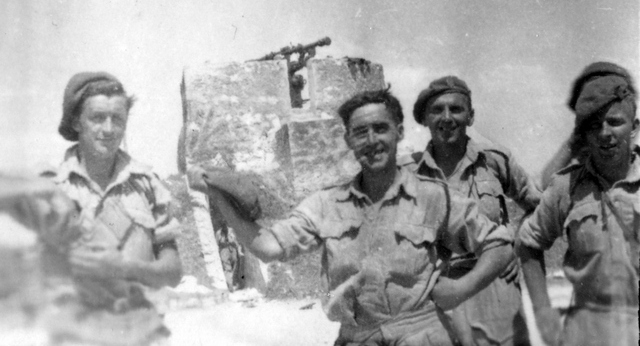
In one of the opening moves of Operation Husky, the Allied invasion of Sicily, Major Paddy Mayne’s SAS Special Raiding Squadron (SRS) destroyed an Italian gun battery in the pre-dawn hours of 10 July 1943 [story]. The battery, called Lamba Doria, sat on the southern tip of the Maddalena Peninsula south of Syracuse. Here, on top of a headland called Cape Murro di Porco, the Italians had direct line of sight of the invasion beaches. The battery’s three 6 inch guns could have wreaked havoc on Allied troop transports anchored like sitting ducks offshore. The SRS had been told that the success of the entire invasion depended on them knocking out the guns before they could open fire.
The SRS were led by Major Paddy Mayne. Mayne had a reputation as a gifted leader and a natural-born warrior. He also had a reputation for having little respect for senior officers, and for going his own way. Thanks to books and TV documentaries, the word ‘rogue’ has become firmly attached, rightly or wrongly, to both Paddy Mayne and his men. When used in this way, the word cleverly combines both the sense of ‘maverick’ and ‘lovable rogue’.
So did Paddy Mayne ‘go rogue’ in Sicily? His orders appear to have given him wide latitude, so disobeying them would seem hard to do. They read:
“On completion of your task your Sqn will either:-
(a) Rejoin ULSTER MONARCH [the SRS’ mother ship] direct.
For this purpose you will make arrangements to summon the craft to the Beach or other embarkation points selected by you, or
(b) Move WESTWARDS to join 5 Div, who will be moving NORTHWARDS from Beach 44 towards SYRACUSE.
The method to be adopted is left to your discretion on the spot; the object being to get your Sqn on board ULSTER MONARCH as soon as possible, and re-organised for further seaborne operations.
If, during your withdrawal, you make contact with other hostile Batteries or defended localities you will, if the task, in your judgement, is within the power of your Sqn, destroy them.”
Other units were warned where they might come across the SRS, to avoid friendly-fire incidents. After destroying the guns on the cape, the SRS were expected to head towards the nearest flat beach, which was in the armpit of the Maddalena Peninsula, near an area called Terrauzza [story]. This was also the nearest place where a road exited the Peninsula. From there the SRS could either re-embark for the HMS Ulster Monarch, or they could head due west towards the main highway. Here they would encounter the main force heading north to capture Syracuse.
But the SRS never got as far as the beach at Terrauzza. At first it seemed as if Mayne had indeed decided to go back to the ship, and HMS Ulster Monarch sent a signal at 07:40 to Corps HQ which read: “SRS moving by craft to UM”.
This implied the SRS were on board landing craft and already on their way back, but in fact they got no closer to the beach than Masseria Damerio, a farm which they had seized at the start of the operation [story]. It now served as the rallying point for regrouping after the fight at Lamba Doria [story].
The SRS after-action report, probably written by Paddy Mayne himself, explained what happened next:
“The main task being successfully achieved the Squadron assembled at Farm DAMERIO and Major R.B.Mayne, D.S.O decided to push North-westwards and attack C.D. [coast defence] Battery which had opened fire on us.”
Well, that is what one version of the report said. The official version in the copy of the War Diary in the National Archives is significantly different. It reads:
“The main task being successfully achieved the Sqdn assembled at Farm “DAMERIO” and Major R.B.Mayne, D.S.O decided to then pushed North-Westwards and attack C.D. Bty 165267 which had opened fire on our shipping.”
Mention of Mayne as the maker of the decision, along with his full title, is so heavily redacted in this version that it is unreadable. And the reason given for taking this decision is no longer that he objected to being fired on, but that he feared for the safety of the invasion ships. This, after all, was why the SRS had landed here in the first place.
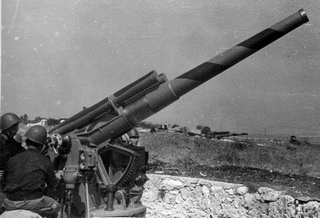
Why is this version different? Did Mayne perhaps feel that by not heading west he had exceeded his orders? After all, these stipulated that his top priority was to return to the ship soon, and ordered him to head due west if he did not re-embark on the beach. Did he think emphasising that it was his decision might be seen as too egotistical? Or did he want to play down any impression that he had gone rogue just for the sake of a good fight, something which he famously adored?
As to whether the second battery fired at the SRS, or the shipping, or both, there are conflicting reports. At least two accounts by SRS men say the battery fired only on ships, but an Italian report mentions the battery firing on approaching enemy troops, although it’s not clear which. The second battery was known as AS 493 by the Italians, with the ‘AS’ identifying it as one of many batteries in the Augusta and Syracuse Fortified Zone.
The SRS report continued:
“Left Farm DAMERIO at about 0600 hrs and proceeding towards new objective mopped up several bunches of enemy snipers and defended Farms.”
There is a photograph of the SRS at one of these farms, Casa Mallia, which sits close to the high point of the ridge. The photograph shows the men taking a break. One man is having a wash with a basin of water and a towel supplied by a young Italian woman. Two men are still wearing their blow-up life-belts, as if a sea journey was still an imminent possibility. A PIAT anti-tank weapon is propped against a wall. A pile of discarded Italian helmets and rifles implies the farm was garrisoned when the SRS arrived.
The house had a small turret on its roof. This gave wonderful views over the peninsula, and it was possible to see battery AS 493 a mile away, especially its large rangefinder tower. Mayne ordered the SRS mortars to bombard the battery while 1 and 2 Troops advanced to capture it and put it out of action.
The SRS report continues:
“Pushing forwards 3” Mortars engaged C. D. Rangefinder and Gun positions.”
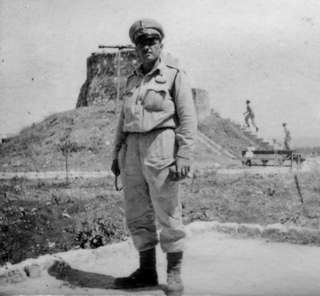
AS 493 was a dual-purpose battery, with both an anti-aircraft and an anti-ship role. The battery’s rangefinder was a large stereoscopic device for measuring the exact distance to a target such as a ship. It was mounted in what looked like a turret on top of a pyramid, to give it maximum height and view. Usually in Italian batteries there was a bunker-like room below the range-finder, which was the fire control centre, from where instructions went to the guns.
The SRS mortar detachment was commanded by Captain Alex Muirhead. He kept detailed notes of its fire missions that morning. His mortars had already done sterling work in the taking of the Lamba Doria battery, opening the attack by firing 60 HE (high explosive) shells and 12 smoke shells. Muirhead recorded that he had learned lessons from this first action:
“Hits on buildings & gun area by H.E. causing casualties & confusion. Smoke [shells] caught 2 cordite dumps. Smoke invaluable as incendiaries [on] houses or grassland. H.E on hitting tile roof penetrates before exploding.”
Muirhead now repeated a similar mix of shell types in a series of fire missions against AS 493. The first was fired at a range of 1700 yards, from near Casa Mallia. “Bursts in the target area” were seen. The team then moved forward 250 yards, to a position in front of the farm, and fired again. This time there was “one hit on Range Finder tower”.
Finally the SRS mortar men went forward almost as far as AS 493 itself, and cheekily fired on it from an improbably point-blank range of 250 yards. It seems they set up behind a house close to the battery’s perimeter, with Muirhead noting:
“Possible to fire at this range if no wind or behind house. Hits in gun pits”.
We have several accounts by Italian gunners in AS 493. One of them, an officer, noted the effectiveness of the SRS mortar fire. The officer had earlier led a patrol towards Lamba Doria, which he discovered had been overrun. He wrote:
“I immediately turned back, and re-entering the battery I phoned Group South HQ and told them everything. Until then they had been completely in the dark about the true situation. Together with my commander we prepared the battery for close-quarters defence.
I descended into the fire control centre and prepared maps and waited for orders and coordinates for the battery to fire on land. But that did not happen, as the commander spotted a formation of fighters and started AA fire. I advised him to stop the pointless AA fire and prepare to fire on land. A little later I spotted significant Allied landing forces […] Then the commander suddenly began fire on these forces with the only two guns which could bear: No. 4 and No. 5. The salvos were effective, but shortly afterwards the gun pit of No. 5 gun took a direct hit from a mortar bomb. Another fell near the fire control centre. Some men were wounded, and others killed. We began firing with an 8mm machinegun, but soon this position also took a direct hit.”
The SRS report on this attack concluded:
“Nos. 1 and 2 Troop attacked and after meeting with strong opposition No. 2 Troop captured the Gun position numbering:
5 A.A. Guns 75 to 80mm
1 Large Rangefinder.
4 4” Mortars.
Several M.Gs and L.M.Gs.”
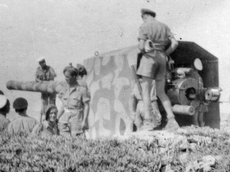
The guns were in fact 102/35 (102mm) anti-aircraft guns. The claim that 4-inch mortars were captured is odd. Gun batteries did not tend to have a complement of mortars, and certainly not such big ones. There was a platoon of 3-inch (81mm) mortars of the Italian 385th Coastal Battalion somewhere on the Maddalena Peninsula. Perhaps it was in the precincts of the battery, or adjacent to it, and this is what the SAS found.
The capture of AS 493 fully vindicated Mayne’s decision to head north rather than west, but more was yet to come. Up ahead were two more batteries guarding the entrance to Syracuse’s harbour.
One was another anti-ship battery like Lamba Doria, this one called Emanuele Russo. The SRS report describes how the battery was captured by just a handful of troopers:
“No. 1 Troop went forward and one section captured gun position 156287 […] Prisoners Battery commander and personnel.”
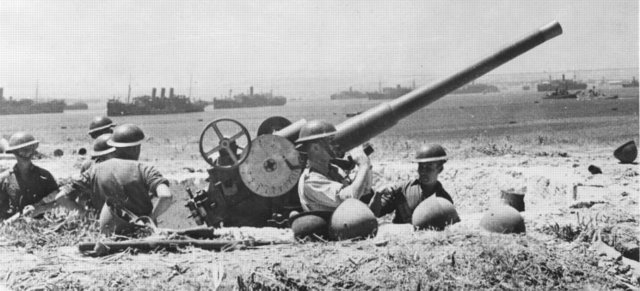
The other, and last, battery was numbered AS 309. It consisted of six 76mm dual-purpose guns. It was dealt with by Muirhead’s mortars alone. He wrote that the results of firing 22 bombs at it were:
“Cordite dump on fire. Hits on guns or barracks[.] H.Q. evacuate[d]”
Muirhead’s mortar men were the unsung heroes of the clearing of the Maddalena Peninsula. They carried the heavy mortar tubes and base plates, and scores of rounds of heavy ammunition, for miles in scorching sun and intense heat. They then fired with verve and accuracy, and to telling effect.
After the last two batteries had been dealt with, Mayne finally led his men westwards. They spent the night at a farm called Luogo Ulivo. It was only a thousand yards from the highway where the SRS had been expected to join the main force on the first day. Instead they did this the next morning, the 11th, nearly a day late. This had no detrimental effect on the possible further operations mentioned in Mayne’s instructions, as apparently no such operations were required on the 11th. It was not until the next day, in the afternoon of the 12th, that the SRS set sail again in Ulster Monarch on an operation, this time to capture the port of Augusta [story].
Whether Mayne obeyed or disobeyed his orders, or merely slightly bent them, nobody was complaining. Acting on his initiative had paid handsome dividends. Whether he had gone rogue or not, however, it seems he could not resist being roguish. He completed his report with a prank.
Reporting on the overnight stay at Luogo Ulivo, Mayne wrote that at the farm his men had captured
“50 Gallini and normal complement.”
As Mayne no doubt fervently hoped, this was reworked by the CO of all the special forces, who put this in his official report:
“On the next day the S.R.S. captured 50 more prisoners which were sent back with those captured previously under escort of the 5th Div.”
Mayne was no respecter of senior officers, and this was a trick that worked spectacularly well. For “Gallini” were not in fact some species of Italian soldiery, but hens, and the normal complement of hens is, of course, eggs.
.
Thanks to the Muirhead family for permission to use a photo from Alex Muirhead’s album and to quote from his archives.
Thanks to Paul Davis for permission to use photos from Peter Davis’ album. Peter Davis’ book “SAS Men in the Making” can be bought from the publisher here.


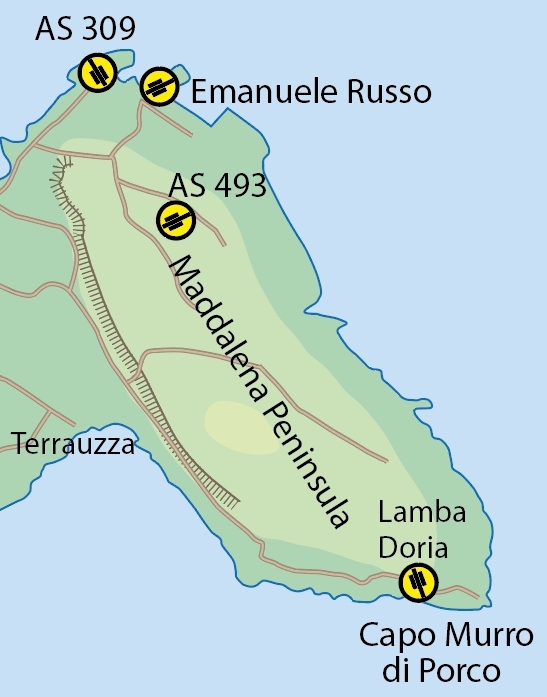
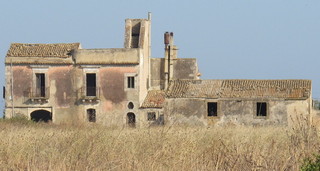
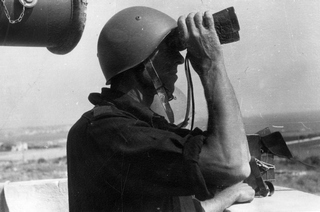

Great to re read this article again, was on the peninsula last week, and visited all of these sights.
Yes, I followed your adventures on Facebook. It looked like you had a great time. Thanks for your kind words – comments like yours are extremely rewarding.
Great article: we clambered over the rocky shore of Capo Murro di Porco last week and in and out of the buildings of the battery. Your report has helped us understand better what went on. We were shown around by a young Sicilian history enthusiast and it was very moving.